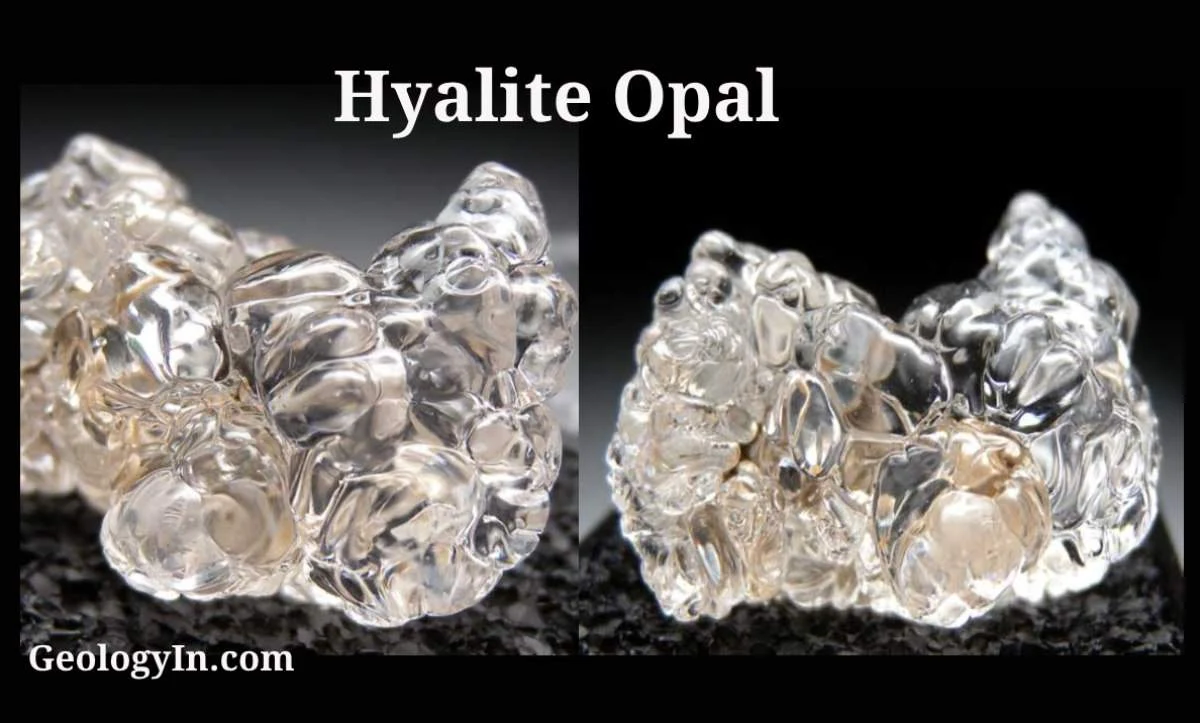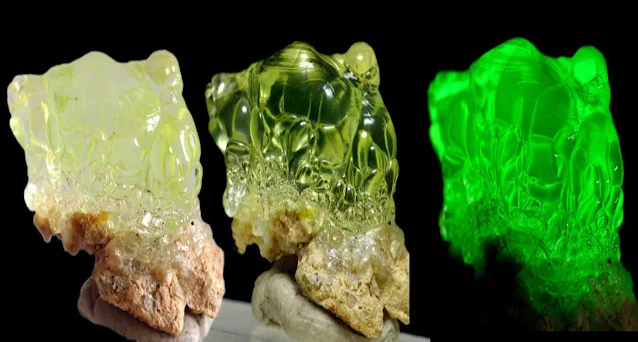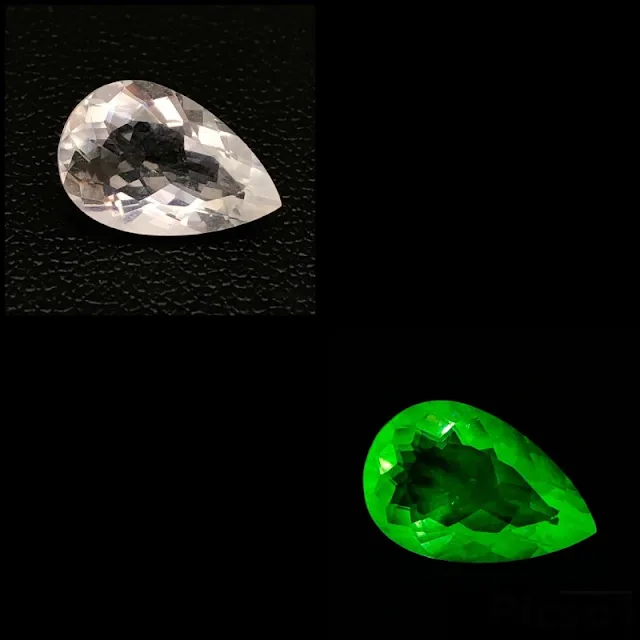What is Hyalite Opal
Hyalite Opal is a distinctive gemstone renowned for its glassy, transparent to translucent appearance. Unlike many other opals, Hyalite Opal is characterized by its clear, colorless, and glassy look, often displaying a faint greenish or bluish hue.
This unique gemstone typically forms in botryoidal (grape-like) clusters or as coatings on other minerals. One of its striking features is its ability to fluoresce bright green under shortwave ultraviolet light. Notably, Hyalite Opal does not exhibit the vibrant play-of-color seen in other opals, which is caused by the diffraction of light.
Technically, Hyalite Opal is classified as an opaloid rather than a true opal. This distinction is made because, while Hyalite Opal shares some characteristics with opals, it does not meet all the criteria required to be considered a true opal.
Hyalite opal, also known as water opal, Muller's glass, or jalite, is a gemstone with a glassy luster. Müller's glass is named after its discoverer, Franz-Joseph Müller von Reichenstein.
 |
| Hyalite ,Waltsch, Bohemia, Czech Republic Photo: Marin Mineral |
Hyalite opal is not considered a true opal by the International Gemological Institute (IGI) and the Gemological Institute of America (GIA). This is because it lacks the internal structure of common opal, which is responsible for the characteristic play-of-color. Hyalite opal is amorphous, meaning it lacks a regular crystal structure, unlike common opal's microcrystalline structure of silica spheres.
Hyalite Opal Formation
Volcanic: Commonly found in volcanic vugs, cavities, and fractures within ash-flow tuffs or rhyolites. These regions have experienced hot, silica-rich fluids from hydrothermal activity or cooling magma, which deposit dissolved silica that solidifies into hyalite.
Pegmatite pockets: In granitic pegmatites, pockets of late-stage fluids rich in silica and other minerals can crystallize as hyalite alongside other gemstones.
Fumaroles: Hot springs and fumaroles in geothermal areas sometimes deposit hyalite, especially if the fluids are abundant in silica and cool rapidly.
 |
| Hyalite opal, Waltsch, Bohemia, Czech Republic Photo: Henk Smeets/Tomeik Minerals. |
Hyalite Opal Properties
Composition: Primarily hydrated silica dioxide (SiO₂·nH₂O), where "n" represents the variable amount of water molecules bound within the structure. This water content contributes to its transparency and softness. Water content ranging from 2-13%.
Structure: Amorphous, meaning it lacks the regular, repeating crystal lattice arrangement of some minerals. This contributes to its glass-like appearance and luminescence.
Appearance: Transparent to translucent with a glassy luster, like water trapped in stone. Colorless to white, sometimes with a subtle green or blue tint. Can exhibit a faint play of color if inclusions are present.
Hardness: Relatively soft, with a Mohs hardness of 5.5-6.5. Requires careful handling and protection from scratches.
Luminescence: Bright green fluorescence under ultraviolet light, a distinctive characteristic of hyalite opal.
Fluorescence: One of hyalite opal's most remarkable features is its brilliant green fluorescence under ultraviolet light. This makes it a favorite among mineral collectors and adds to its otherworldly charm.
Luster: Vitreous, resembling the shine of glass.
Porous: Absorbs water and other liquids easily, requiring careful cleaning and storage.
Heat sensitive: Can crack or lose its luminescence with excessive heat.
Pleochroism: Weak, colorless to pale green
Specific Gravity: 2.1 - 2.3: Slightly denser than water, reflecting its higher silica content compared to common opal.
Pleochroism: Weak or absent: Does not exhibit significant variation in color when viewed from different directions.
Refractive Index: 1.44 - 1.48: Lower than many other opals, contributing to its slightly milky appearance.
 |
| Hyalite Opal with daylight, LED and UV light fluorescence, from Zacatecas, Mexico. Photo: Spiriferminerals.com |
When exposed to shortwave UV, fluorescent hyalite opal comes alive with an intense green glow. This luminescence can range from a soft emerald green to a vibrant lime green, depending on the specimen.
Hyalite Opal Uses
Practical Uses
Jewelry: Hyalite opal's translucent beauty makes it a stunning choice for cabochons in rings, necklaces, and earrings. Its milky white or gray color offers a unique, ethereal aesthetic.
Collectors' Gem: Due to its rarity and mesmerizing green fluorescence under ultraviolet light, hyalite opal is prized by mineral collectors.
Decorative Flair: Translucent hyalite opal shines beautifully in sculptures and ornaments, adding a touch of elegance to home décor.
Metaphysical Uses
Emotional Healing & Clarity: Hyalite opal is believed to possess calming and cleansing properties, helping to clear negative energies and promote emotional well-being. It's said to bring clarity and focus to the mind, aiding in decision-making and creative pursuits.
Spiritual Growth: Associated with the crown and third eye chakras, hyalite opal is believed to facilitate spiritual growth and connection to higher realms. It's said to enhance intuition, promote astral travel, and open doors to new perspectives.
Meditation & Guidance: The calming and centering energy of hyalite opal makes it a valuable aid in meditation. It's believed to help connect with spiritual guides and facilitate deeper inner exploration.
 |
| Hyalite Opal Jewelry |
Overall, hyalite opal is a captivating gemstone with a unique story and mesmerizing beauty. Whether you're drawn to its ethereal appearance, its geological origins, or its potential metaphysical properties, hyalite opal offers a glimpse into the wonders of the natural world.
Read also:
Types of Opal With Photos
Matrix Opal
Honeycomb Opal

%20(1).webp)






